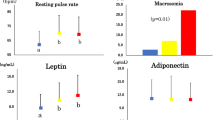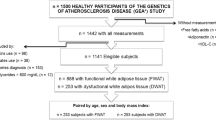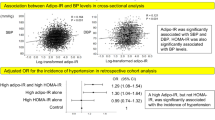Abstract
BACKGROUND: Abdominal obesity is an important risk factor for the development of non-insulin dependent diabetes mellitus and other atherogenic disorders. The recently discovered fat-derived hormone leptin has been proposed to regulate adiposity through stimulation of satiety and increased energy expenditure. This study was undertaken to examine the relationship between fasting plasma leptin, body fat distribution and atherogenic complications in markedly obese adult subjects. SUBJECTS: The study comprised 29 women and 26 men who all were obese but otherwise healthy (body mass index, BMI, 33–60 kg/m2). RESULTS: In 37 of the obese subjects, who were characterized in detail, the fasting plasma leptin levels correlated with plasma insulin (−0.34) but not in a significant way with blood pressure, insulin sensitivity, plasma glucose tolerance or circulating concentrations of glucose, lipoproteins, catecholamines or plasminogen activator inhibitor-1. In the whole patient material the fasting plasma leptin levels were two times higher in women than in men who had similar body mass index values (P<0.0001), In spite of the fact that all subjects were massively obese, the plasma leptin values correlated positively with BMI (r=0.39, P=0.004). On the other hand, there was a negative correlation between plasma leptin and waist-to-hip ratio (r=0.65, P=0.0001), which was independent of BMI. CONCLUSION: Except for a quite weak relationship with fasting plasma insulin, leptin appears not to be associated with classical metabolic atherogenic complications to obesity. Instead, it may protect obese subjects with a gynoid fat distribution from metabolic complications. About 40% of the variation in leptin in massively obese subjects could in fact be explained by peripheral fat distribution.
This is a preview of subscription content, access via your institution
Access options
Subscribe to this journal
Receive 12 print issues and online access
$259.00 per year
only $21.58 per issue
Buy this article
- Purchase on Springer Link
- Instant access to full article PDF
Prices may be subject to local taxes which are calculated during checkout
Similar content being viewed by others
Author information
Authors and Affiliations
Rights and permissions
About this article
Cite this article
Lönnqvist, F., Wennlund, A. & Arner, P. Relationship between circulating leptin and peripheral fat distribution in obese subjects. Int J Obes 21, 255–260 (1997). https://doi.org/10.1038/sj.ijo.0800394
Received:
Accepted:
Issue Date:
DOI: https://doi.org/10.1038/sj.ijo.0800394
Keywords
This article is cited by
-
Associations of leptin and adiponectin with incident type 2 diabetes and interactions among African Americans: the Jackson heart study
BMC Endocrine Disorders (2020)
-
Gluteofemoral body fat as a determinant of metabolic health
International Journal of Obesity (2010)
-
Alterations in body composition in acromegaly
Pituitary (2009)
-
Leptin, Superoxide Dismutase, and Weight Loss: Initial Leptin Predicts Weight Loss
Obesity (2006)
-
The global epidemic of obesity: Are we becoming more sympathetic?
Current Hypertension Reports (2004)



